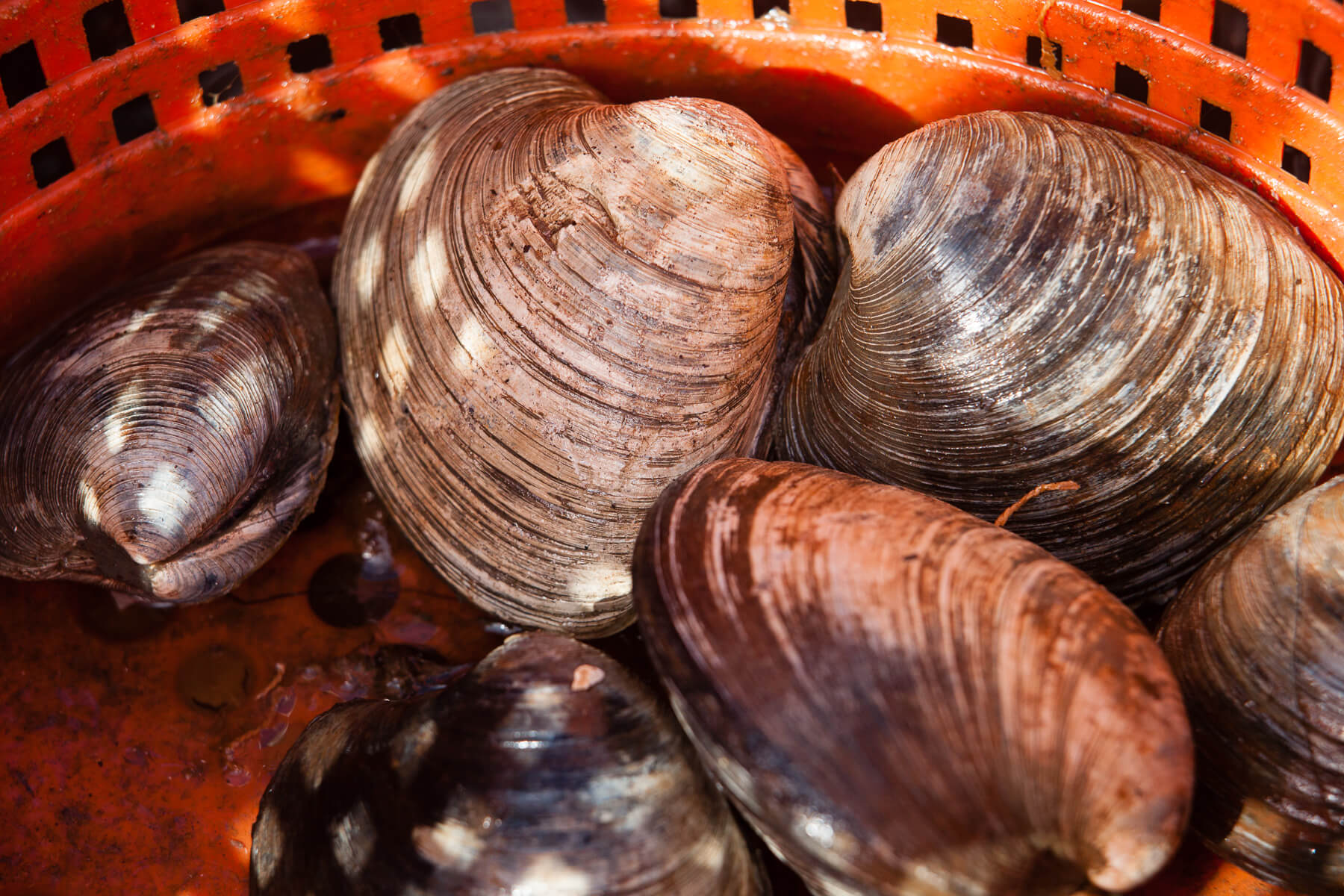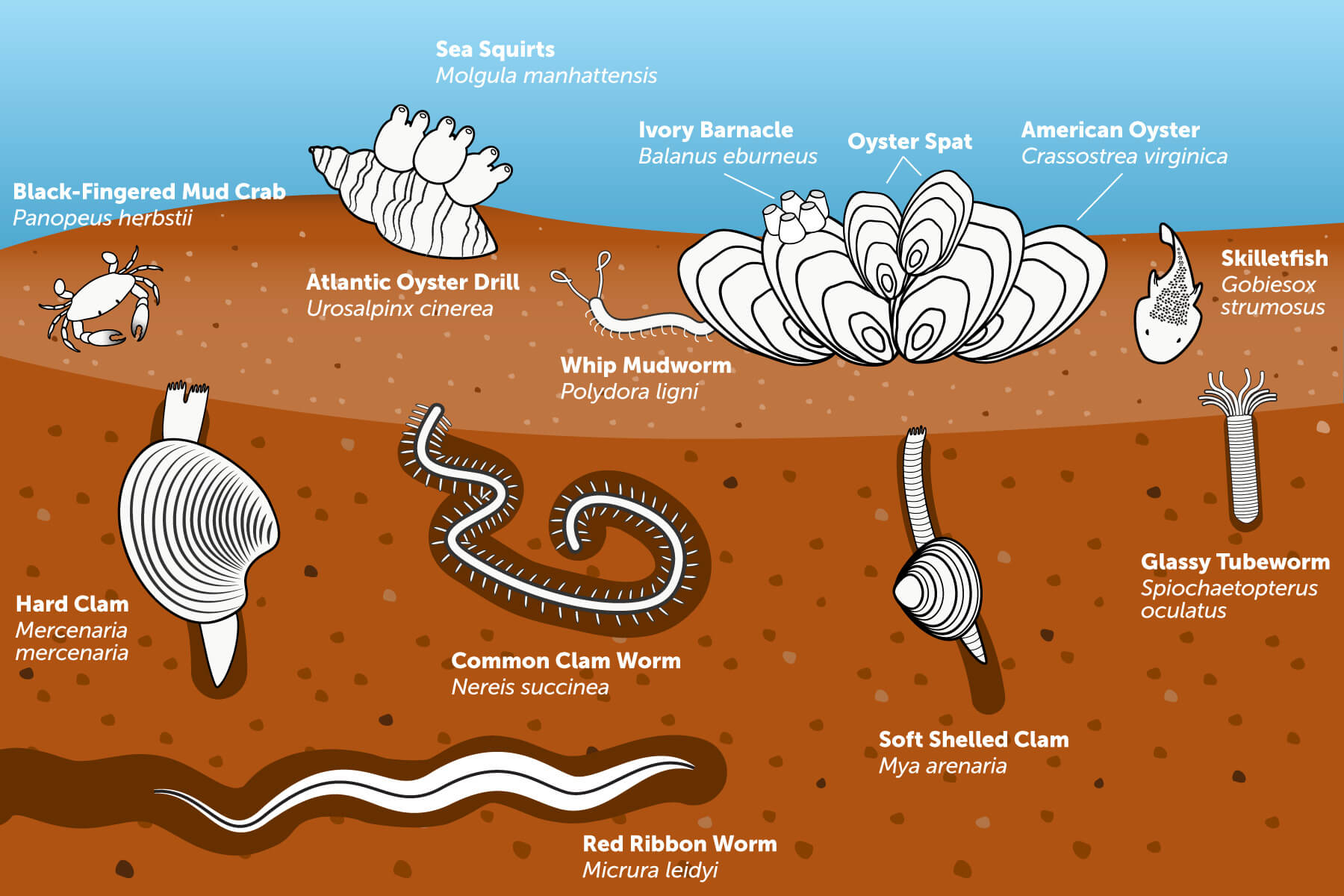Where Would You Most Likely Find Benthos Organisms?

Benthos are the organisms that live at the bottom of the Chesapeake Bay and its streams and rivers. The give-and-take benthos comes from a Greek term meaning "depths of the body of water." Benthic communities are complex and include a wide range of animals, plants and bacteria from all levels of the nutrient web. Clams, worms, oysters, shrimp-like crustaceans and mussels are all examples of benthic organisms.
What types of benthic organisms alive in the Chesapeake Bay?
There are two groups of benthic organisms, based on their habitat: epifauna and infauna. Epifauna live attached to a surface and infauna live within bottom sediments.
Epifauna
Epifauna alive attached to difficult surfaces such as rocks, shells and pilings or directly on the surface of the Bay's bottom. Epifauna include oysters, sponges, sea squirts, sea stars and barnacles. An oyster reef is an example of an epifaunal benthic community.
Infauna
Infauna burrow into bottom sediments. Worms, clams and other infauna form their own communities that are connected to the h2o by tubes and tunnels. A salubrious infaunal community contains many different species.
A typical healthy benthic community

Why are benthic organisms important?
Benthos play several of import roles in the food web and serve equally an excellent indicator of environmental weather in the Bay and its streams and rivers.
An important link in the food spider web
Benthos link primary producers—phytoplankton—with higher levels in the food web.
- Filter feeders such equally clams and oysters consume plankton and organic particles.
- Many benthic creatures, particularly clams and worms, serve as nutrient for larger, economically important species such as bluish crabs, striped bass, spot, croaker and white perch.
Additionally, the bacteria, decomposers and detritus-feeders that live at the lesser of the Bay suspension downwardly waste product products and dead plants and animals.
An ecology snapshot
Scientists study benthic organisms because they provide a skillful snapshot of environmental conditions in the Bay and its streams and rivers. Virtually benthic creatures cannot move very far—if at all—then they can't avert pollution or unhealthy h2o atmospheric condition.
Benthic communities are exposed to many stressors, including low oxygen levels, excess sediment and chemical contaminants.
- In summer, high temperatures and food pollution often atomic number 82 to low-oxygen areas at the bottom of the Bay and its rivers.
- Excess sediment suspended in the h2o can block sunlight from reaching bay grasses growing at the bottom. When sediment finally settles, it can bury oyster confined and other benthic species.
- Many chemical contaminants bind to bottom sediments, remaining there for years. Benthic species get contaminated when they feed and live in these toxic sediments.
Working with the Maryland Department of Natural Resource and Virginia Department of Environmental Quality, the Chesapeake Bay Program has monitored the health of benthic organisms in the tidal Chesapeake Bay since 1984. Each yr, researchers with the Chesapeake Bay Benthic Monitoring Programme collect hundreds of samples and compare species abundance, biomass, diversity and other attributes to conditions that would exist expected in a healthy surround. The sample results are then scored on a one-to-five calibration called the Benthic Index of Biotic Integrity, or B-IBI.
Over the past decade, the health of bottom habitat in the tidal Bay has remained poor. Researchers did observe pocket-sized improvements in 2015, however, with 62 percent of the Bay's tidal bottom coming together restoration goals (compared to 59 percent in 2014). In other words, while 38 percent of the tidal Bay's bottom habitat is marginal, degraded or severely degraded—home to more pollution-tolerant species, fewer species overall, fewer large organisms deep in the sediment and a lower total mass of organisms—almost ii-thirds of this habitat is home to a healthy community of benthic organisms. Furthermore, the extent of degraded and severely degraded weather was the lowest it has been since 1996. Experts attribute this improvement in lesser habitat to improvements in dissolved oxygen. Improvements in bottom water quality are thought to be the result of low leap river flow, which meant lower polluted runoff flowing into the Bay.
Source: https://www.chesapeakebay.net/discover/ecosystem/life_at_the_bottom
Posted by: davisinscurs36.blogspot.com

0 Response to "Where Would You Most Likely Find Benthos Organisms?"
Post a Comment